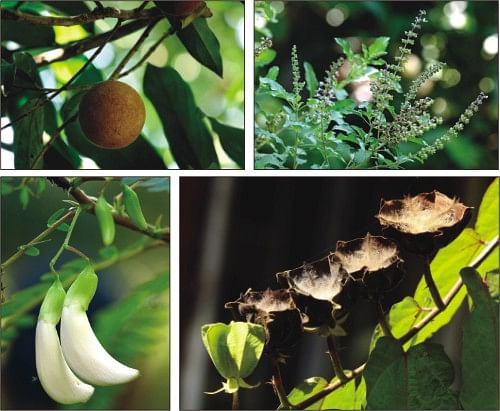Nurturing the rare plants

(Clockwise) Chalmugra helps fight leprosy. Tulsi heals cough and common cold. Ulot Kombol helps cure many intestinal ailments. Bokphool, also used as a food item in the rural areas. Photos By Syed Zakir Hossain
The rare medicinal plant collection at the National Botanical Garden in Mirpur is getting more attention in recent times from enthusiasts amid growing popularity of herbal medicines in the country.
At the first sight it appears to be an ordinary garden full of trees, herbs and shrubberies that usually grow in the wild across Bangladesh but the plant variety in its collection has many wonders to offer.
The medicinal plant section covers about 3 acres of land nurturing nearly 170 species of rare valuable plants. The collection is based on indigenous species.
Zayed Hossain Bhuiyan, director, National Botanical Garden, said the main objective of the garden is to collect and conserve the fast-disappearing species of plants with rich medicinal value.
“Medicinal plants grow almost everywhere, sometimes in our backyard but we fail to value them for lack of knowledge about the wonders they have to offer,” said Bhuiyan.
The botanical garden is a live documentation of these medicinal plants and many more indigenous and exotic plants species. The purpose of the garden is to categorise, document, conserve, research and display for scientific purposes. It also entertain and educate the general public, said the director.
Botanical garden also sells these medicinal plants to interested growers and users.
Established in 1962 covering an area of about 208 acres of land the botanical garden has about 56,000 individual trees, herbs, and shrubs of 950 species including its huge collection of medicinal plants.
The garden is divided into 57 sections and is managed by Forest Department under the Ministry of Environment and Forests.
The assortment of the medicinal plants includes rare varieties such as Malabar nut (Basak), Snake root (Sharpa gondha), Devil's cotton (Ulot kombol), Common basil (Tulsi), Thorn apple (Dhutora), The creat (Kaal megha), Periwinkle (Nayantara), Life plant (Pathor kuchi), Arjun, Ashok, Chaste tree (Nishinda), Aloe Vera (Ghrito kumari), Neem, Sandal wood, Henna, Devil's tree (Chhatim), Pennywort (Thaankuni), Curry leaves, Hydnocarpus (Chalmugra) and many more.
Extracts of these plants are commonly used in many modern medicines. Alternative medicine practitioners (Ayurvedic) and traditional healers also value these plants very much. And herbal medicine is becoming more popular.
“If we could blend the practice of using medicinal plants with our modern lifestyle it will help keep us healthy for life,” Bhuiyan added.
In Bangladesh about 500 medicinal plants have been found. However, over population and deforestation have led to the extinction of many species. About 106 medicinal plant species have been listed as endangered. But the issue still remains widely ignored.
There is no government policy or rules and regulations about the medicinal plants cultivation, conservation and marketing in the country. Only a few non-governmental organisations and university faculties are working on the plants.
Shamsul Haque, chief botanist of the botanical garden said, about 80 percent rural population in the country used to be completely dependent on medicinal plants for their primary health care but it gradually lost its footing.
“The local people conserved traditional knowledge through their experience and practices, which was handed down orally without any documentation,” said Haque.
Providing technical support in cultivation and raising awareness among the general public about its magic effect can give back its status in the country, he noted.

 For all latest news, follow The Daily Star's Google News channel.
For all latest news, follow The Daily Star's Google News channel. 



Comments